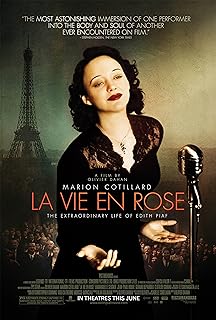電影訊息
電影評論更多影評

2008-05-02 11:13:57
Edith Piaf 生平
看完片子,很震撼,同時有點暈。
的確,把人生濃縮到一部電影有點難。在網上找來Edith Piaf的生平介紹:
百度百科 http://baike.baidu.com/view/1453968.htm
生平介紹:
Edith Piaf ,原名Edith Gassion,1915年12月19日出生於巴黎。有傳說她母親是在巴黎街道的路燈邊生下她的,但事實上她是在當地的醫院出生的。父親Louis-Alphonse Gassion是一位街頭雜耍藝人,母親Anita Maillard是個賣唱的歌女,藝名叫Line Marsa。跟剛打算退役的法國足球巨星齊達內一樣,Piaf的母親Anita是有卡比利亞(北非阿爾及利亞地區民族,也稱柏柏爾人,在依比利斯半島活動,多為流浪者)血統的「下等法國人」。第一次世界大戰期間,父親從軍,母親在街頭賣藝討生活,根本無暇照顧女兒,Edith在幼年時,只得與在諾曼第的奶奶相依為命。在鄉間,她度過了幾年快樂的時光。戰爭結束後,父親把她接回身邊,她的生活開始沒有什麼幸福可言,為了生活,他們的草台班子在全法國流浪表演(世界名著、都德的《小東西》就描寫了很多流浪藝人的艱辛),可憐的Edith,早早領略了生活的艱難。可能是家庭的遺傳,Piaf天生一副好嗓子,漸漸地,她也正式成了戲班子裡的一員。15歲的時候,這位鄉下小妹子決心離開父親,獨自去巴黎闖蕩。1932年,她與同為流浪藝人的Louis Dupon,一年後育有一女Marcelle,但這個小女孩只活了兩歲就因腦膜炎而夭折 。Edith繼續在街頭賣唱,直到有一天,Louis Leplée——座落在香榭麗舍大道(Avenue des Champs Elysées)的巴黎最優雅的酒吧之一le Gerny's的老闆——無意間聽到這個年輕姑娘的演唱,立刻被這個嬌小女人的嗓音迷住了。他立刻簽下了她,並為她取藝名為拉·莫姆·琵雅芙(在巴黎方言中,這是小鳥的意思)。Piaf的身高只有1.47m,確實像一隻楚楚可憐的小鳥。琵雅芙是將多愁善感、幽默和嚴酷的現實主義極好地結合起來,她是法國傳統歌曲的化身。
從1936年開始,直至去世,琵雅芙錄製了許多專輯。她的最後一首歌是L'hommede Berlin,這是她在1963年初錄製的。琵雅芙在世的時候並不富裕。事實上,琵雅芙經歷過多次車禍,還有毒品困擾,她去世時還給比她小很多歲的第二任丈夫留下一大筆債務。琵雅芙的一生輝煌但短暫,她以她的方式給我們帶來了無盡的歡樂。
歷程:
老闆Louis對她寵愛有加,並在36年為她錄製了第一張唱片Les M?mes de la cloche(「鄉下姑娘」的意思)。但苦命的Piaf總是那麼不幸:那年4月,Louis Leplée被人在自己的家中謀殺!Piaf因與他有密切關係而被被警方傳訊……各種「娛樂媒體」便大肆渲染這段「傳奇」。
Piaf失去了靠山,但她關鍵時刻總有貴人相助,她的一個「粉絲」Raymond Asso,一位知名的冒險家,幫助她迅速擺脫了那些煩人的事情並離開了le Gerny's酒吧。在Raymond Asso的引導下,Piaf慢慢脫去了鄉下女子的土氣和在父母的市井階層所沾染上的俗氣,最後成為大家所熟悉的那個Edith Piaf——一副迷茫的神情,一副無助的樣子,頭髮淒淒,嘴唇腥紅,雙臂沿著起皺的黑色毛衣下垂……她已經不再是鄉下的小鳥,她成了巴黎的尤物。這一年,她拍攝了第一部電影,Jean Limur導演的La gar?onne,幾個月後又是第二部電影Bobino。40年,她與戲劇演員Paul Meurisse同居Paul教會Piaf很多東西,特別是如何得體地處理社會上的種種問題。劇作家Jean Cocteau為他們兩度身編寫了一部話劇Le bel indifférent,在夫婿及Jean Cocteau的幫助下,Piaf的表演獲得極大成功,這部戲也激發了她對戲劇的興趣,展現了她的表演天分。
隨後,夫妻倆一起出演了Georges Lacombe的電影Montmartre sur scène。拍攝過程中,Piaf與電影音樂作者Henri Contet結下了特殊的友情,Henri後來成為Piaf最主要的詞曲作者。
當年這隻楚楚可憐的小鳥逐漸羽翼豐滿了,二戰期間,Piaf已經可以勇敢地以自己的方式反抗佔領者:她不顧德國人的警告,堅持與猶太音樂家合作並演出。此時的她已經變得成熟,不單指其性格,也指她的藝術表現形式以及她與社會方方面面協調的能力。她巧妙周旋在各種勢力之間,利用自己的經驗和成就,實現自己的意願。
44年,初到巴黎的毛頭小子Yves Montand闖入了她的生活。年過30的她不顧一切愛上了他,並張開翅膀保護這個初到巴黎的鄉下小伙。Piaf已經不是小鳥,她成了保護女神和引路人。可能與Yves有類似的幼年生活經歷,她對Yves既有情人的愛,也有一種近乎母愛的情感。她為把自己的製作團隊介紹給Yves,她讓她的「御用」作曲家Henri Contet為小伙子寫出了Yves最早的成名曲Battling Joe及Luna park。
她一步步將Yves引入社交界,指導他閱讀,交遊,使他很快與巴黎融入一體(看到這裡,小伙子們都動心了嗎?)。45年,她與Montand合演了電影Etoile sans lumière。
在45年以前,Piaf只有一首有影響力的歌曲是由她自己填詞的,那就是La vie en Rose(Louiguy作曲)。這首歌曾經被她周圍的人認為意識太超前,不會受歡迎,但結果是如今這首歌已經幾乎成了Chanson(法語單詞,「歌曲」的意思。港台將其翻譯成更加美感的「香頌」)的代名詞。
46年,Piaf注意到年輕的創作歌手組合Cmopagnons de la Chanson,她非常欣賞他們的才幹。為自己與Yves著想,她設法將他們網羅到門下,專為她自己和Yves寫歌作曲。在她的促成下,發行了一張專輯Les trois cloches,Yves藉此獲得1百萬張唱片的銷量……但不知什麼樣的原因,這一年,她與Yves莫名地分開了。也許是她預見了Yves不可限量的未來,所以選擇了悄悄地離開……在我所聽過的男聲的La vie en Rose的版本中,Yves的和美國黑人Louis Armstrong的兩個版本是我最喜歡的。
也許是為了散心,也許是為了擺脫過去。47年她第一次赴美國開演唱會,將Cmopagnons de la Chanson也一併帶了過去。 這次新大陸之行對Piaf實在是一次挑戰,在紐約Playhouse最初的幾場演出只能算失敗,美國佬並不了解這個女人,當然,語言也是理解的障礙。不過她決定繼續留下來,而且把演出場地也搬到了曼哈頓(Manhattan)。她越來越成功,漸漸打開了新大陸市場。當然她的收穫還不止於此:她與演員、歌手Marlène Dietrich成為了終生的好朋友,同時與著名拳手Marcel Cerdan墮入情網。這段拳王與歌后的愛情故事成為47年大小報紙津津樂道的話題。
Piaf與Cerdan的幸福是充實的,那時,她與Marguerite Monnot合作為有情人寫下了著名的香頌:L'hymne à l'amour——她的又一首不朽的經典。
但厄運似乎總不願遠離這個不幸而成功的女人,49年10月28日,Marcel Cerdan突然因空難而故去,傳奇變成了悲劇。這次巨大的打擊使Piaf在有生之年,再也沒有真正地解脫出來……回顧往事,她愛的男人,總是被一股神秘、意外的力量從她身邊被奪走。她變成了神秘主義者和宿命論者。
不過,這個堅強的女人並沒有停止工作,50年她返回巴黎,在Pleyel繼續演出。這一時期,年輕的詞曲作家Charles Aznavour成了她身邊的「全能人」:她的秘書,司機和知心人。事實上,自45年起,她就開始利用自己的影響在幫助CHARLES,只不過她沒有象幫助Yves或Les Compagnons de la Chanson那樣提攜Charles罷了。但忠實的Aznavour依然對她唸唸不忘,為她寫下很多優秀的歌曲。
1951年,Piaf再次找到了新的保護人——年輕的美國舞蹈演員兼歌手Eddie Constantine。但這段故事僅僅維持了7個月,神秘事件再次發生:這回是她自己,她連續遇上兩起交通意外,其中第二次差點要了她的命。治療過程中,她染上了毒癮,自此再也未能從這個可怕的嗜好中掙扎出來……
連續的打擊,使她沉迷於毒品與酒精,這嚴重損害了她的身體……她似乎想借婚姻改變命運,1952年7月,她與歌手Jacques Pills舉行了她一直夢想的第一次正式的婚禮。婚後,他們雙雙赴美演出,她演出了新婚夫婿Jacques Pills為她寫的幾首作品。這是她第5次赴美演出,當然,當年讓她打開新大陸之門的Le Versailles那裡依然是必去的。
這一年她經歷了幾次毒品不良反應,身體情況非常糟糕。但也在這年,她達到了她個人藝術事業的最高峰,巡迴演唱會不斷。她糟糕的身體幾乎拖垮了她。53-54年,她不得不閉門修養。但是,當55年接到在奧林匹亞劇場(所有歌手的聖地)的邀請後,Piaf再次煥發出令人驚奇的激情和能量,這次演出獲得極大的成功,鼓舞了她繼續演藝事業的信心。
58年再次在奧林匹亞演唱會上,她演出了她另一首重要作品Mon manège à moi。之後,她認識了歌手、曲作家Georges Moustaki,9月她與Georges竟然又一次遇上了嚴重的交通事故……隨後,在紐約的演唱會上,Piaf倒在了舞台上。似乎預見來日無多,她拒絕了朋友們、醫生的建議,堅持60年的奧林匹亞演唱會照舊進行。
Piaf的玫瑰色人生還未結束,61年夏天,她結識了她生命中最後一個男人——Theophanis Lamboukas,她叫他Sarapo(希臘語「我愛你」的意思),這個希臘歌手陪她走完了人生最後的一段旅程。這年7月,她在祖國法國接受了「終身成就大獎」。62年9月25日,在巴黎艾菲爾鐵塔下為全巴黎演唱了Le Jour le plus long,她的光耀無與倫比。
維基百科http://en.wikipedia.org/wiki/%C3%89dith_Piaf
Early life
Despite numerous published biographies, much of Piaf's life is shrouded in mystery.[2] She was born Édith Giovanna Gassion[3] in Belleville, Paris, the high-immigration district later described by Daniel Pennac. Legend has it that she was born on the pavement of Rue de Belleville 72, but her birth certificate states she was born at Hôpital Tenon,[4] the hospital for the 20th arrondissement of which Belleville is part. She was named Édith after the World War I British nurse Edith Cavell, who was executed for helping French soldiers escape from German captivity.[5] Piaf—a Francilien colloquialism for "sparrow"—originated as a nickname she would receive 20 years later.
Her mother, Annetta Giovanna Maillard (1895–1945), was a French pied noir of French-Italian descent on her father's side and of Kabyle Berber origin on her mother's. She was a native of Livorno, a port city on the western edge of Tuscany, Italy. She was working as a café singer under the name Line Marsa.[4] Louis-Alphonse Gassion (1881–1944), Piaf's father, was a Norman street acrobat[6] with a past in the theatre. Piaf's parents soon abandoned her, and she lived for a short time with her Kabyle maternal grandmother, Emma (Aïcha) Saïd ben Mohammed (1876–1930). Before enlisting with the French Army in 1916 to fight in World War I, her father took Piaf to his mother, who ran a Normandy brothel. The prostitutes helped look after Piaf.[1]
From the age of three to seven, Piaf was allegedly blind as a result of keratitis. According to one of her biographies, she recovered her sight after her grandmother's prostitutes pooled money to send her on a pilgrimage honoring Saint Thérèse de Lisieux, resulting in a miraculous healing. In 1929, at 14, she joined her father in his acrobatic street performances all over France, where she first sang in public.[1] She took a room at Grand Hôtel de Clermont (18 rue Veron, Paris 18ème) and separated from him, going her own way as a street singer in Pigalle, Ménilmontant, and the Paris suburbs (cf. the song "Elle fréquentait la Rue Pigalle"). She joined her friend Simone Berteaut ("Mômone")[4] in this endeavor, and the two became lifelong partners in mischief.[1] She was about 16 when she fell in love with Louis Dupont, a delivery boy.[1] At 17, she had her only child, a girl named Marcelle, who died of meningitis at age two.[6] Like her mother, Piaf found it difficult to care for a child while living a life of the streets, so she often left Marcelle alone while she was away, and Dupont raised the child before her death.[1] Piaf's next boyfriend was a pimp named Albert who took a commission from the money she made singing in exchange for not forcing her into prostitution. One of her friends, a girl named Nadia, killed herself when faced with the thought of becoming a prostitute, and Albert nearly shot Piaf when she ended the relationship in reaction to Nadia's death.[1]
[edit] Singing career
In 1935 Piaf was discovered in the Pigalle area of Paris[1] by the nightclub owner Louis Leplée,[3] whose club Le Gerny off the Champs Élysées[6] was frequented by the upper and lower classes alike. He persuaded her to sing despite her extreme nervousness, which, combined with her height of only 147 cm (4 feet 8 inches),[7][4] inspired him to give her the nickname that would stay with her for the rest of her life and serve as her stage name, La Môme Piaf[3] (The Waif Sparrow, Little Sparrow or Kid Sparrow in Parigot slang).[1] Leplée taught her the basics of stage presence and told her to wear a black dress which would later become her trademark apparel.[1] Leplée ran a large publicity campaign prior to her opening night, which resulted in a number of celebrities including actor Maurice Chevalier attending the opening.[1] Her nightclub gigs led to her first two records produced that same year,[7] with one of them penned by Marguerite Monnot, an ongoing collaborator throughout Piaf's life.[1]
On April 6, 1936,[1] Leplée was murdered and Piaf was questioned in the matter and accused of being an accessory, but she was acquitted.[3] He had been killed by mobsters with previous ties to Piaf.[8] This resulted in much negative media attention directed towards Piaf,[4] which threatened her career.[1] To rehabilitate her image, she recruited Raymond Asso, with whom she would also become romantically involved. He changed her stage name to "Édith Piaf," barred her undesirable acquaintances from seeing her, and commissioned Monnot to write songs that reflected or alluded to Piaf's previous life on the streets.[1]
In 1940, Édith co-starred in Jean Cocteau's successful one-act play Le Bel Indifférent.[1] She began to make friends with famous people, such as Chevalier and the poet Jacques Borgeat. She wrote the lyrics of many of her songs and collaborated with composers on the tunes. In 1944, Édith Piaf discovered Yves Montand in Paris, made him part of her act, and became his mentor[4] and lover.[8] Within a year, he became one of the most famous singers in France, and she broke off their relationship when he had become almost as popular as she was.[1]
During this time, she was in great demand and very successful in Paris[3] as France's most popular entertainer.[7] After the war, she became known internationally,[3] touring Europe, the United States, and South America. She helped to launch the career of Charles Aznavour in the early 1950s, taking him on tour with her in France and the United States and recording some of his songs.[1] At first she met with little success with US audiences, who regarded her as downcast.[1] After a glowing review by a prominent 紐約 critic, though, she met with better success[1] and her popularity in the United States was such that she appeared on the Ed Sullivan Show eight times and at Carnegie Hall twice (1956[6] and 1957).
Edith Piaf's signature song "La vie en rose"[1] was written in 1945 and was voted a Grammy Hall of Fame Award in 1998.
The legendary Paris Olympia concert hall is where Piaf achieved lasting fame, giving several series of concerts at the hall, the most famous venue in Paris,[4] between January 1955 and October 1962. Excerpts from five of these concerts (1955, 1956, 1958, 1961, 1962) were issued on record and CD and have never been out of print. The 1961 concerts were promised by Piaf in an effort to save the venue from bankruptcy and where she debuted her song "Non, je ne regrette rien".[4] In April 1963, Piaf recorded her last song, "L'homme de Berlin".
[edit] World War II
During World War II, she was a frequent performer at German Forces social gatherings in occupied France, and many considered her a traitor; following the war she claimed to have been working for the French resistance. While there is no evidence of this per se, it does seem to be true that she was instrumental in helping a number of individuals (including at least one Jew) escape Nazi persecution. Throughout it all, she remained a national and international favorite.[9] Piaf dated a Jewish pianist during this time and co-wrote a subtle protest song with Monnot.[1] According to one story, singing for high-ranking Germans at the One Two Two Club[10] earned Piaf the right to pose for photographs with French prisoners of war, to boost their morale. The Frenchmen were supposedly able to cut out their photos and use them as forged passport photos,[10] and some of them managed to escape.
[edit] Personal life
The love of Piaf's life,[3] the married boxer Marcel Cerdan, died in a plane crash in October 1949, while flying from Paris to 紐約 City to meet her. Cerdan's Air France flight, flown on a Lockheed Constellation, went down in the Azores, killing everyone on board, including famous violinist Ginette Neveu.[11] Piaf and Cerdan's affair made international headlines,[4] as Cerdan was the middleweight world champion and a legend in France in his own right. Piaf was later married twice. Her first husband was Jacques Pills, a singer. They married in 1952 (Piaf's maid of honour was Marlene Dietrich) and divorced in 1956. Her second husband, Théo Sarapo, was a Greek hairdresser-turned-singer and actor[1] who was 20 years younger than Piaf. They married in 1962 and sang together in some of her last engagements.[1]
In 1951 Piaf was involved in a car crash along with Aznavour, breaking an arm and two ribs, and thereafter had difficulty breaking serious morphine and alcohol addictions.[1] Two more near-fatal car crashes exacerbated the situation.[6] Her first husband, Jacques Pills, took her into rehabilitation on three different occasions to no avail.[1]
Death and legacy
The grave of Édith Piaf, Père Lachaise Cemetery, ParisPiaf died of liver cancer at Plascassier, on the French Riviera, on 10 October 1963, but officially made public on the 11th, the same day that her friend Jean Cocteau died.[12] She slipped in and out of consciousness for the last months of her life.[6] It is said that Sarapo drove her body back to Paris secretly so that fans would think she had died in her hometown.[1][10] She is buried in Père Lachaise Cemetery, in Paris, where her grave is one of the most visited.[1]
評論

